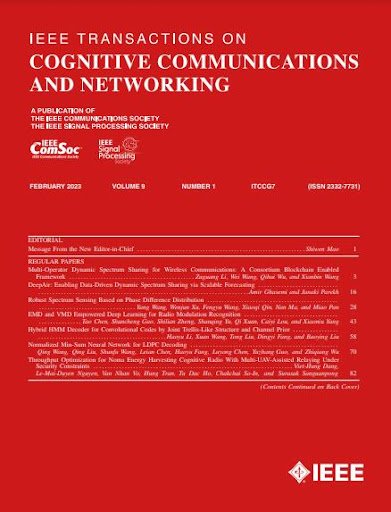

Journal Name: IEEE Transactions on Cognitive Communications and Networking
Overview
The IEEE Transactions on Cognitive Communications and Networking (TCCN) is a leading peer-reviewed journal dedicated to advancing research and development in the rapidly evolving fields of cognitive radio, dynamic spectrum access, and intelligent wireless networks. Published by the Institute of Electrical and Electronics Engineers (IEEE), TCCN serves as a vital platform for academics, researchers, engineers, and industry professionals who are shaping the future of wireless communication through innovative cognitive networking technologies.
What is Cognitive Communications and Networking?
Cognitive communication refers to systems that can intelligently sense, learn from, and adapt to their environment in real-time. This adaptability enhances spectrum efficiency, reduces interference, and improves overall network performance. In cognitive networking, devices and infrastructure use artificial intelligence (AI), machine learning (ML), and real-time data to optimize communication protocols and decision-making. These technologies are crucial for 5G, 6G, and future wireless networks.
Key Areas Covered by IEEE TCCN
IEEE TCCN covers a broad range of topics in cognitive and intelligent communications, including:
-
Dynamic Spectrum Access (DSA)
Techniques that allow devices to opportunistically use underutilized spectrum, improving bandwidth efficiency. -
Cognitive Radio Networks (CRNs)
Intelligent radio systems that can dynamically adjust parameters based on spectrum availability and user requirements. -
Machine Learning and AI for Wireless
Algorithms and models that enable learning-based decision-making in wireless communication systems. -
Spectrum Sensing and Management
Innovative methods for detecting available channels and managing spectrum usage. -
Security and Privacy in Cognitive Networks
Approaches to protect cognitive networks from vulnerabilities, unauthorized access, and malicious attacks. -
Applications in 5G/6G and IoT
Integration of cognitive communication techniques into next-generation networks and Internet of Things ecosystems.
Why IEEE TCCN is Important
IEEE TCCN plays a critical role in bridging the gap between theoretical research and practical implementations of cognitive communications. As the demand for faster, smarter, and more efficient networks increases, the need for intelligent spectrum management becomes more pressing. TCCN fosters collaboration across academia and industry, encouraging innovative solutions that address real-world wireless communication challenges.
The journal maintains a high standard of quality through rigorous peer-review, ensuring that only the most impactful and original research is published. Contributions include original research articles, survey papers, technical notes, and in-depth reviews.
SEO Keywords:
-
Cognitive communications
-
Cognitive radio
-
Dynamic spectrum access
-
IEEE TCCN journal
-
Intelligent wireless networks
-
Machine learning in wireless
-
Cognitive networking
-
Spectrum sensing and management
-
AI in 5G/6G
About
In the era of 5G, 6G, and beyond, network intelligence has become more critical than ever. As spectrum resources become increasingly scarce, and data traffic continues to grow, cognitive technologies offer promising solutions. By enabling smarter spectrum management, minimizing interference, and optimizing resource allocation, cognitive communications can significantly improve the efficiency and reliability of wireless networks.
IEEE TCCN plays a crucial role in sharing the latest breakthroughs in this space. It helps bridge the gap between academic research and real-world applications, fostering innovation that can shape the future of wireless and cognitive networks.
Key Features of the Journal
-
High-Quality Peer-Reviewed Articles: Each submission goes through a rigorous peer-review process ensuring technical accuracy, novelty, and relevance.
-
Quarterly Publication: Published four times a year, providing timely insights into emerging trends.
-
Interdisciplinary Focus: Combines aspects of electrical engineering, computer science, machine learning, and wireless communications.
Who Should Read or Submit to IEEE TCCN?
IEEE TCCN is an essential resource for:
-
Academic researchers and students in communications and networking
-
Industry professionals working in telecom, AI, and IoT
-
Policymakers and regulators interested in dynamic spectrum management
-
Startups and innovators focusing on smart wireless technologies
If you are conducting cutting-edge research on cognitive radios, spectrum sensing, or intelligent network architectures, submitting your work to IEEE TCCN can increase your visibility and impact in the global research community.
Scope
The IEEE Transactions on Cognitive Communications and Networking (TCCN) is a leading peer-reviewed journal published by the IEEE Communications Society. It serves as a premier platform for researchers, engineers, and academics who are exploring the next frontier in intelligent and adaptive communication systems. This journal focuses on the growing need for smart, self-learning networks that can dynamically adjust to complex and changing environments — a field known as cognitive communications.
What is Cognitive Communications and Networking?
Cognitive communications and networking refer to systems that can sense, learn, and adapt based on the surrounding radio environment. These systems use artificial intelligence, machine learning, and statistical modeling to optimize spectrum use, enhance signal transmission, and manage network resources effectively. As wireless technology continues to evolve with the rise of 5G, 6G, IoT, and edge computing, cognitive networking has become increasingly critical for maintaining efficiency and performance.
Core Topics Covered by IEEE TCCN
The IEEE Transactions on Cognitive Communications and Networking covers a wide range of topics, including but not limited to:
-
Cognitive Radio Networks (CRNs): Technologies enabling radios to sense the spectrum and dynamically select frequencies to avoid interference.
-
Dynamic Spectrum Access: Techniques that allow more efficient use of the radio spectrum by enabling secondary users to utilize unused licensed bands.
-
Machine Learning in Communications: Integration of AI and deep learning methods into cognitive networks for better decision-making and automation.
-
Resource Allocation and Network Optimization: Algorithms for improving network throughput, latency, and energy efficiency.
-
Security and Privacy in Cognitive Networks: Addressing new challenges introduced by adaptive and decentralized networks.
-
Cooperative and Distributed Sensing: Enhancing spectrum awareness using multiple sensing nodes for improved reliability.
-
Standardization and Applications: Emerging standards and real-world implementations in vehicular networks, smart cities, and military communications.
Why Publish in IEEE TCCN?
Publishing in IEEE TCCN offers high visibility in the academic and industrial research communities. It is indexed in major databases like Scopus, Web of Science, and IEEE Xplore, ensuring your work reaches a global audience. The journal is known for its rigorous peer-review process, technical depth, and contributions from leading researchers in the field.